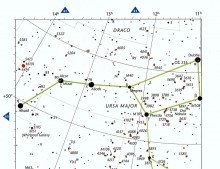I’ve had a couple of brief but brilliant sessions recently, covering an incredible range of astronomical objects. The first, on the night of the 23rd of February, was memorable for the mere fact that I got to watch Jupiter’s Great Red Spot drift slowly across the face of the planet. An app on my phone (Android), JoveMoons, lets me know when the GRS will be visible, and on the 23rd it was front and centre by about 10.30. Despite the nearby presence of the almost full moon, Jupiter was amazing. The brick red colour of the GRS was very obvious, and there was detail to be seen in the main equatorial bands. With little else on show that night, apart from the moon, I watched Jupiter slowly rotate for ages, captivated by the little details that would suddenly appear as our atmosphere allowed.
The moon itself was ace. Only one day old, it was blindingly bright, and although I’m not a ‘moon person’, I have to confess to having enjoyed scanning around its surface, switching eyepieces to better explore the details.
The second night out was on Sunday the 28th. I’d spent most of the previous Saturday flocking the interior of my telescope (covering the inside with a very black, non-reflecting material), and was keen to try it out in the hope that this improved the contrast. I grabbed a couple of hours on Sunday evening in great anticipation. By 8.30 the sky had cleared, and I was all set.
First up was Jupiter again. There being no moon, Jupiter was the brightest thing in the sky. I hadn’t had time to check on JoveMoons, but, incredibly, I was treated to another view of the GRS! Clarity wasn’t as good as the previous outing, but a pleasant surprise nonetheless.
I spent the rest of the evening looking at fainter and more distant objects, with the aim of seeing if the flocking had improved contrast and definition.
M101 (the Pinwheel) and M51 (the Whirlpool) are galaxies close by Ursa Major. The former was very faint (it usually is as its surface brightness is very low), but the latter showed distinct spiral arms and bright cores. Swinging to the right from M51 I found the Sunflower galaxy in Canes Venatici (somewhat faint and indistinct), and from there up to Leo and the Leo Triplet (M65, M66 and NGC 3628). This was fantastic, all three galaxies nicely framed in one field of view, with some subtle detail visible. The latter of the three is much fainter than the others, and is often missed (indeed, Messier missed it when compiling his catalogue despite it being so close to the other two). But there it was, brighter than I’d ever seen it.
Below and to the left of Leo is Virgo, and the large ‘bowl-shaped’ part of the constellation was just appearing over Giant Hill in Cerne Abbas. I must have spent half an hour in this region alone, mesmerised by the profusion of galaxies in the Virgo Supercluster. Even though still low in the atmosphere, and the ‘seeing’ wasn’t great, I counted well over a dozen galaxies, including the incredible sight that is Markarian’s chain. I didn’t bother trying to identify individual ones, I’ll leave that for another, clearer night, when the constellation is higher in the sky.
Seeing this many galaxies in one place reminded me of a recent post I read on the Stargazers Lounge astronomy forum (a highly recommended resource). It mentioned the nine galaxies shown within the bowl of the big dipper (Ursa Major) in Sky & Telescope’s Pocket Sky Atlas. As I happened to have my copy with me, I thought I’d have a look for them. I managed four in the end (NGCs 3982, 3998, 3898 and 3780 – the latter, if, in fact, I did get it, is an incredible 146 million light years a way; a new record for me!), time being rather short because of work in the morning. I’ll definitely return to these another time.
Finally, I swung the scope around to Orion to take a look at the Great Orion Nebula. I’d been convinced of the difference the flocking made, but felt that it was a subtle improvement, rather than a ‘wow!’ type thing. However, the Orion nebula really brought home the improvement. I could see areas of nebulosity that I’d never seen before: brighter clouds, darker patches … A couple of firsts for me were the Running Man nebula (this was very obvious, and had great contrast), and, although I didn’t spot it itself, I did see definite signs of nebulosity around the Horse Head nebula.
It’s amazing what you can pack in to just a few hours!
What’s up?
The eastern sky is a fantastic area at the moment. From Ursa Major in the northeast, through Canes Venatici, Coma Berenices, Virgo and Leo to the southeast there are galaxies in abundance, and even a moderate telescope (a 4-5 inch reflector, for example) will reveal most of the objects I mentioned above). Jupiter, too, is just below Leo, and is set to get bigger and brighter as it approaches opposition on the 8th of March.
This month is also probably the last chance to explore around Orion, as it’s sinking ever lower in the western sky. Once it’s gone, we won’t see it again until the late autumn!
Clear skies!
Kevin Quinn is an amateur astronomer based in Cerne Abbas. He is the proud owner of a ten-inch reflector, a small refractor, a case of eyepieces, and a couple of pairs of binoculars. He tweets via @CerneAstro, and blogs via theastroguy.wordpress.com.
©Kevin Quinn







